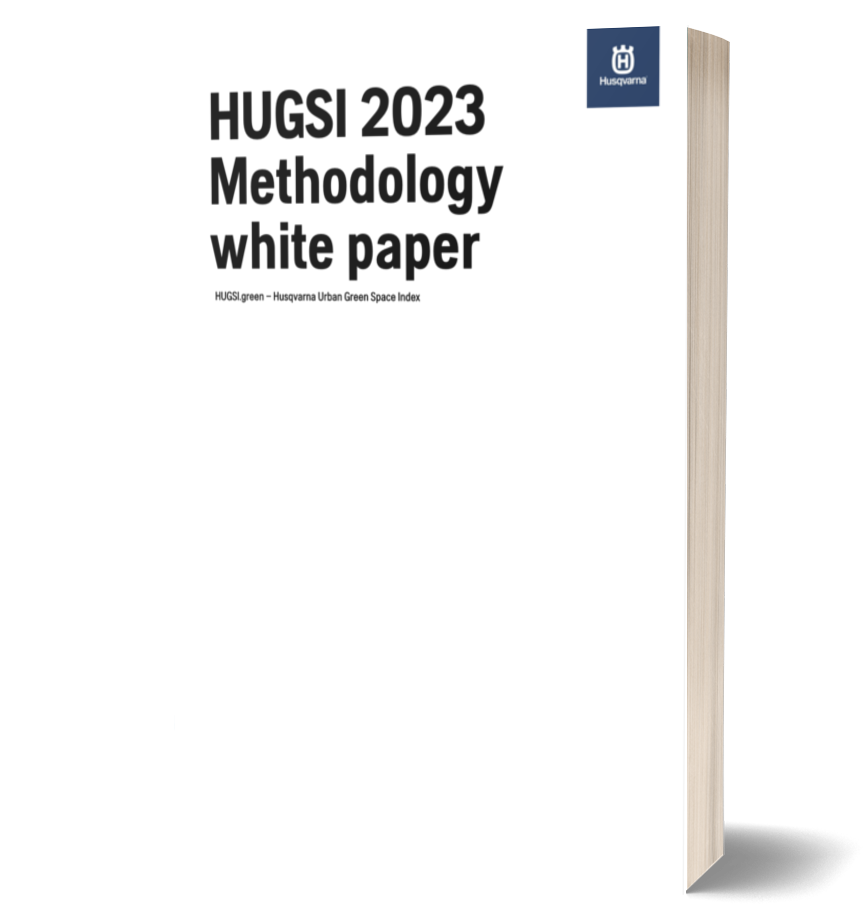How it works
Supporting the greening ambition of global cities through satellite data & AI
HUGSI.green is a service from Husqvarna providing objective and recurring monitoring for hundreds of cities in more than 60 countries using analysis of satellite data.

Analyzing global cities at scale
- Cities are monitored on their individual vegetative prime day.
- We are using global open datasets and apply the same methodology when analyzing all cities to promote benchmarking and collaboration.
- We analyze the data for you, with annual updates. Data is compiled and presented as indicators and visualized on maps and graphs.
- Our methodology is open and full of important definitions and considerations based on scientific sources. Our aim is to deliver a scalable, trustworthy, and consistent source of global, regional and local urban green space data.
Methodology in short
- What area of a city will be analyzed?We focus on urban areas, where many people live. Urban is based on data from the European Commission (GHS-POP).
- Outer boundaries are defined based on maps provided by the city or by Open Street Map Administrative boundaries.
- Urban/populated areas are defined with at least 3,8 people per 100m grid in GHS-POP (Global Human Settlement Layer)
- When during the year is the data captured?Cities are assessed on their individual green prime day of the year, to ensure fair assessment between cities and from year-to-year.
- What data is used to analyze the cities?Cities are analyzed using multispectral data from Sentinel 2 satellites part of the Copernicus program from the European Space Agency (ESA)
Learn more about HUGSI
Videos
Using HUGSI
Methodology
Biodiversity Webinar
Download our Methodology Whitepaper
For anyone that is as nerdy as us and want to learn all details of our methodology we are happy to share our Methodology Whitepaper with you. Happy reading!


Frequently Asked Questions
The index is based on range of factors such as the percentage of urban area covered by vegetation, health of vegetation, and how well the green space is distributed across the urban area. To provide as accurate results as possible the different parameters have been extracted for different types of vegetation separately. Combining values from different categories requires a standardization process before weighing them together. For each type of vegetation, we use its different factors to produce as product distribution which is furthermore transformed into a normal distribution. Using the cumulative distribution function of the normal distribution we obtain a cumulative probability score ranging from 0 to 1. After obtaining the cumulative probability scores for the different types of vegetation they are weighted together and re-scaled into the range 0 to 100 providing the final score.The multiplicative nature of the computations ensures that cities with high values for multiple factors rank higher than cities with very high value for one factor but low for the others.The rationale of including vegetation health and distribution is to better reflect the environmental and recreational values of urban green space. We believe evenly distributed green space across urban area is more accessible by citizens and thus higher recreational value than that concentrated at only a few spots. Besides, healthier vegetation has higher environmental value due to more carbon dioxide absorption and higher oxygen emission. The index puts twice the weight on trees compared to grass to recognize the higher impact they have on the environment - see reference below.Contact us if you're interested in more details about the statistical and analytical methods utilized in HUGSI.
Apart from the index and ranking, cities are given a rating with a label from A-E, where A+ is the top score to achieve. The idea behind this is to have a more stable segmentation based on the green score of cities. Index and ranking are recalculated when new cities are added, the rating is based on certain criteria per label.Cities are rated based on a green score calculated from the Green KPIs per city.
- Green Space percentage
- NDVI/Vitality of green
- Green per capita
- Green distribution
The first round of 98 cities in the initial launch 2019 was selected based on C40 member cities, including temporarily inactive cities with the addition of non C40 members; Gothenburg, Sweden and Marseille, France.57 new cities were selected for 2020 to fill gaps and white space in Europe, North America and India.In 2021 cities part of the 'Green City Challenge' in Netherlands were added by request from the participating cities.From 2022 and onwards, cities apply and pay to monitor their city with annual updates.
To calculate the index we use primarily the Sentinel 2 satellite image dataset. This data is captured by satellites operated by European Space Agency (ESA) and made publicly available by The European Commission's Copernicus program in collaboration with ESA. Additional satellite image data, such as high-resolution satellite imagery from Airbus and Maxar, are used to complement and validate the results.Satellite image data is acquired from the Copernicus program, and it has been modified to establish our base dataset. For the avoidance of doubt, it should be clarified that HUGSI is not officially endorsed or affiliated with any European Union institution.
Deep learning techniques are utilized to process the satellite image data and extract relevant metrics from the raw images.As a subset of machine learning, deep learning leverages deep neural networks to effectively learn from unstructured data (such as satellite images) and reveal patterns, characteristics and insights.
City boundaries are defined based on a municipal map that the city shares with us. If there is no suitable municipal map, we use OpenStreetMap (OSM) administrative boundaries to define the outer boundaries of the area to analyze.
Define urban areas:
Population data from Global Human Settlement Layer (GHS-POP) is used to adjust the area to analyze within defined city boundaries.To foucs our analysis on urban centers and urban clusters, according to the GHS-POP terminology) we apply the following rules:GHS-POP divides a city into grids of 100 by 100 meters and measures average density of population in each grid. Our approach excludes tiles with less than 1000 people per square mile (3.8608 people per 100m by 100m) and includes islands (smaller areas disconnected from the main body of a city) with more than 5000 people residing are included.For more information on GHS-POP, please see Schiavina, Marcello; Freire, Sergio; Alessandra Carioli; MacManus, Kytt (2023): GHS-POP R2023A - GHS population grid multitemporal (1975-2030). European Commission, Joint Research Centre (JRC) [Dataset] doi: 10.2905/2FF68A52-5B5B-4A22-8F40-C41DA8332CFEPID: http://data.europa.eu/89h/2ff68a52-5b5b-4a22-8f40-c41da8332cfeAfter we have defined the outer boundaries and the inner populated boundary, we add a 300m buffer around the filtered boundaries to include surrounding areas. This resulting area is regarded as the urban area for a city which is used followed in all further calculations.This method produces three important output:- Urban area to use in the analysis of a city
- Actual area of the city in m² that the analysis cover
- Estimated population for the measured area
So, any population numbers or city area referred to on the platform is according to the logic described above. It is most often not the same as the official population or area of a city or municipality as we only focus on urban areas.
HUGSI uses a machine learning model differentiate trees from other vegetation including bush using image recognition. The model is trained on visually labeled dataset in which trees has been classified, other vegetation is considered to be grass. Shrubs/bushes would enter either class as there are no strict definition.
The results are produced through our thorough and open methodology.HUGSI focus on globally scalable analytics and can be used to derive current state, development and changes for a city, cities, region and globally.The results provided are validated by data scientists and domain experts and believed to be very accurate. A thorough approach of testing and validation is employed in data processing with deep learning to ensure deep understanding of the performance and continuous optimization of the algorithms.Legal disclaimer: All results are assumptions based on our open methodology and the AI-models used.www.hugsi.green/terms-of-use
We’re open to share the metrics for a city or area of your interest upon request. Drop us a message and we’re happy to discuss.
We encourage usage of the data provided in HUGSI.green to be used in academic research, reports, by NGO’s and also by commercial companies for various purpose. You are not allowed to share our data in its entirety but to use parts as a sub component of a new output.Always reference us as HUGSI.green – Husqvarna Urban Green Space Insights. Since our data is updated with a yearly cadence it is also recommended to refer to what year data was captured.Please also inform us when you are using data from HUGSI.green, it is always nice to know. Send us an email to hello@hugsi.green
To ensure fair assessment between cities and from year-to-year all cities are assessed on their individual green prime day of the year. In this way we avoid seasonality and can always focus on the best available data. Sometimes satellite data includes to many clouds from the actual best day – in that case we will combine images form the best available tiles to one mosaic.
After the order has been recognized and payments made, we need approx. 10 weeks to onboard your city to the platform.
As default we analyze the two most recent full years and onboard it to the platform. As an addon cities may request additional years stretching back to 2015 for European cities and 2018 for the rest of the world.
Yes, the numbers we share per city on the total area size in square kilometers may differ from the official numbers. We start with your outer administrative boundary, shared by you or taken from Open streetmap, within this boundary we isolate the urban areas fitting our criterias.The size of the HUGSI-boundary is what we share per city. Most often the size of the boundary defined by us is smaller than the official boundary. We have different definitions.
Yes, the numbers we share per city on the urban population may differ from the official numbers. Our population data is the Global Human Settlement Layer (GHS-POP) provided by the European Commission and we only include the population living within the HUGSI-boundary.Most often the population data defined by us is smaller than the official numbers. We have different definitions.